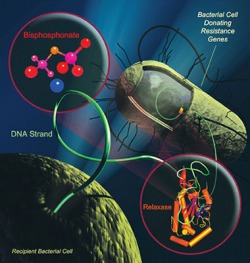Bacteria Resistance to Antibiotics - a Global Problem

Since the invention of the microscope, we have realized that in the air that we breed, on the sheets that covers our beds, on the food that we eat, on our skin and evenly inside our bodies lives tiny little creatures, measuring a few micrones, called bacteria. The majority of the bacteria species that surround us are friendly, living in mutualism with human beings. Other (a small number of bacteria species) are pathogenes, living as parasites on/in other living creatures (including humans). Pathogenic bacteria are a major cause of human death and disease, causing infection such as tetanus, typhoid fever, syphilis, leprosy, diphtheria, cholera, foodborne illness and tuberculosis.
Tuberculosis is, in present, the most common bacterial disease. It is caused by the bacterium Mycobacterium tuberculosis. This disease kills every year about 2 million people, mostly in Third World Countries (more exactly in the sub-Saharan- Africa). Other globally spread diseases are pneumonia (caused by bacteria species such as Streptococcus and Pseudomonas) and foodborne illnesses (caused by bacteria species such as Shigella, Campylobacter and Salmonella).
Worldwide, infections produced by bacteria are treated with substances called antibiotics. Exist 2 classes of antibiotics: bacteriocidal (witch kill the bacteria) and bacteriostatic (witch prevent the bacterial growth). The antibiotics are produced nowadays on a large scale using usually aerobic fermentation of different kind of microorganisms. Some newer antibiotics are produced artificially in chemical laboratories, using different biochemical processes.
Antibiotics must be used only with a doctor's prescription, where the dosage and duration of the antibiotic treatment are specified. The following of the prescription and the completion of the entire antibiotic course is extremely important. Not fallowing the doctor prescription facilitates the bacterial populations to become more and more antibiotic resistant. Inappropriate antibiotic treatment (like the use of antibiotics to treat viral infections such as the common cold - that have no effect because the antibiotics doesn't kill viruses) is another form of antibiotic misuse.
So, I hope I've cleared the fact that people contribute on a large scale to the development of antibiotic resistance of the infecting bacteria. The antibiotic resistance has become a serious problem on the entire Globe, not only in developed countries, but also in the undeveloped ones. Because the rate of the antibiotic resistance is so high, low-cost antibiotics are useless for treating the common bacteria infections. This leads to more frequent use of newer and expensive artificial antibiotics, witch in turn leads to the rise of resistance these compounds to.
After you have read this article, you should think twice when you may use antibiotics treatment and when you may not, and also go to your doctor for the prescription and fallow it. Do not use antibiotics when you don't need it!
Tuberculosis is, in present, the most common bacterial disease. It is caused by the bacterium Mycobacterium tuberculosis. This disease kills every year about 2 million people, mostly in Third World Countries (more exactly in the sub-Saharan- Africa). Other globally spread diseases are pneumonia (caused by bacteria species such as Streptococcus and Pseudomonas) and foodborne illnesses (caused by bacteria species such as Shigella, Campylobacter and Salmonella).
Worldwide, infections produced by bacteria are treated with substances called antibiotics. Exist 2 classes of antibiotics: bacteriocidal (witch kill the bacteria) and bacteriostatic (witch prevent the bacterial growth). The antibiotics are produced nowadays on a large scale using usually aerobic fermentation of different kind of microorganisms. Some newer antibiotics are produced artificially in chemical laboratories, using different biochemical processes.
Antibiotics must be used only with a doctor's prescription, where the dosage and duration of the antibiotic treatment are specified. The following of the prescription and the completion of the entire antibiotic course is extremely important. Not fallowing the doctor prescription facilitates the bacterial populations to become more and more antibiotic resistant. Inappropriate antibiotic treatment (like the use of antibiotics to treat viral infections such as the common cold - that have no effect because the antibiotics doesn't kill viruses) is another form of antibiotic misuse.
So, I hope I've cleared the fact that people contribute on a large scale to the development of antibiotic resistance of the infecting bacteria. The antibiotic resistance has become a serious problem on the entire Globe, not only in developed countries, but also in the undeveloped ones. Because the rate of the antibiotic resistance is so high, low-cost antibiotics are useless for treating the common bacteria infections. This leads to more frequent use of newer and expensive artificial antibiotics, witch in turn leads to the rise of resistance these compounds to.
After you have read this article, you should think twice when you may use antibiotics treatment and when you may not, and also go to your doctor for the prescription and fallow it. Do not use antibiotics when you don't need it!
